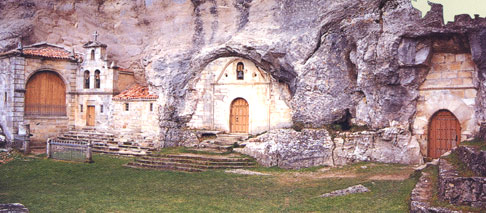
Cottage La Toba is located on the outskirts of the town of Bezana, in the Valle de Valdebezana, near of the Cantabrian mountain range, in the north of the province of Burgos, and included in the Las Merindades comarche. The Valley, in the Natural Park of Hoces del Alto Ebro and Rudrón, hides among its small towns, the most varied artistic and natural treasures.
Among all its natural spaces we can highlight the narrow the Palancas gorge and the impressive Pisas waterfall, formed by the La Gandara stream.
The grasslands near the Ebro reservoir contrast with the summits of the Escudo and the Maza and the Cantabrian Mountains. The Carrales beech forest and the Villabascones and the extensive holm Arreba Valley oak grove, have a high natural interest for its good state of conservation.
In this last valley, furrowed by the river Trifón, where the weakness of the limestone rock has favored the formation of different cavities of Piscarciano, Arenas and cows karstic complex.
The Ojo Guareña caves, located about 20 km. of the house, with its more than 100 km. of underground galleries, they form the largest karst complex in Spain and one of the largest in Europe.

The Puentedey picturesque village, built on a natural bridge, belongs to the nearby Sotoscueva district.
To the south of Carrales port and next to the rural house La Toba is located the Sedano region.
Although even the smallest of the villages deserves a visit, we highlight:
Sedano, capital of the Valley. Irrigated by transparent water from the Moradillo River, its houses, in which the houses of ashlar masonry emblazoned abound. It is possible to emphasize the palace tower of the Bustillo. Presiding throughout the town is, on a rocky promontory, an imposing church with 17th century facade.
Covanera You have to get lost in the narrow streets of this town, full of well-preserved buildings, where its famous Pozo Azul stands out, a spectacular emergence of water of karstic origin that is considered the biggest siphon in Spain.
Valdelateja. Presiding over this picturesque town stands the striking and isolated Peña de Siero. At its summit the hermitage of the Santas Centola and Elena is discovered. From late Venetian period, it has a valuable horseshoe arch window.
Quintanilla-Escalada. From where the path leads to the venerated hermitage of Nuestra Señora del Ebro.
Pesquera de Ebro. From the narrow road that takes us to the town from the national one, good prospects of the great Ebro canyon are dominated. Something before reaching Pesquera there is a viewpoint to the Canyon. Pesquera de Ebro surprises visitors with an unexpected urban ensemble, set with emblazoned palaces from the 16th, 17th and 18th centuries. Walking through its streets allows us to evoke the past hidalgo of this well-preserved rural center.
In front of Pesquera, one can discover the silhouette of one of the most charming towns in the province of Burgos: Cortiguera. It is worth visiting its farmhouse hanging over the precipices of the Ebro

Orbaneja del Castillo. The best thing is to ascend towards it along the path that goes up a beautiful and noisy waterfall. Numerous houses of clear mountain influence, in which stand out some elegant wooden terraces, open to the old and stepped streets of a farmhouse that takes advantage of its harmonious location a few and narrow tobaceous terraces.
Going through the streets of this town in the High Castile is to evoke an interesting and sometimes mysterious historical past. In Orbaneja Christians, Moors and Jews lived together for centuries. Only the memory of the name of some street remains of the presence of the latter and its famous alijama.
